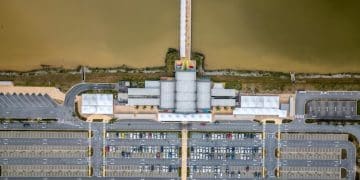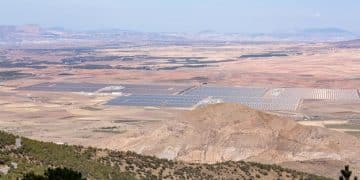US-Mexico Trade: Expert Predictions for Next 5 Years

The future of US-Mexico trade relations is anticipated to be defined by increased nearshoring, energy transition, and evolving geopolitical dynamics, driving significant economic shifts over the next five years, as experts project deeper integration despite potential policy hurdles.
The intricate dance between the United States and Mexico has always been a focal point for economic observers, but as global dynamics shift, understanding The Future of US-Mexico Trade Relations: Expert Predictions for the Next 5 Years becomes paramount. This relationship, anchored by geographical proximity and intertwined supply chains, is poised for both evolutionary shifts and potential disruptions.
In a world grappling with supply chain vulnerabilities and geopolitical realignments, the North American trade corridor, spearheaded by the US-Mexico partnership, is under intense scrutiny. What lies ahead for this vital economic artery? Delving into expert forecasts reveals a tapestry of opportunities and challenges shaping its trajectory over the coming half-decade.
Geopolitical Shifts and Their Impact on Trade
The geopolitical landscape is a dynamic force that profoundly shapes trade relationships, and the US-Mexico dynamic is no exception. As global powers reconfigure alliances and economic strategies, bilateral trade agreements and national policies adjust accordingly. Understanding these macro shifts is crucial for predicting the stability and direction of trade flows.
Recent years have witnessed a global push towards supply chain resilience, often influenced by political tensions and the desire to reduce reliance on distant manufacturing hubs. This trend has naturally favored nearshoring and friendshoring, positioning Mexico as an attractive alternative for many US companies. The strategic importance of critical minerals and energy security also plays a significant role, with both nations seeking to leverage their respective resources.
The Nearshoring Phenomenon
The concept of nearshoring, relocating production closer to consumer markets, has been gaining significant traction, directly benefiting the US-Mexico trade relationship. This phenomenon is driven by a confluence of factors, including rising logistical costs, geopolitical uncertainties, and a desire for shorter, more resilient supply chains. Mexico, with its geographic proximity, competitive labor costs, and established trade infrastructure under the USMCA, stands as a prime beneficiary of this trend.
- Reduced Transit Times: Shorter distances equate to faster delivery and lower transportation costs.
- Enhanced Supply Chain Resilience: Less exposure to geopolitical risks and natural disasters in distant regions.
- Cultural and Time Zone Proximity: Facilitates better communication and collaboration between US and Mexican operations.
This shift is not merely about cost savings but about strategic risk mitigation. Companies are re-evaluating their global footprints, prioritizing continuity and stability over absolute lowest costs. This strategic realignment is expected to significantly boost Mexican manufacturing exports to the U.S., particularly in sectors like automotive, electronics, and medical devices.
Policy Continuity and Potential Disruptions
While the USMCA provides a strong framework for trade, future policy decisions by both governments will inevitably influence its trajectory. Elections in both countries within the next five years could introduce new priorities or even challenges to existing agreements. Anticipating these shifts requires careful monitoring of political rhetoric and proposed legislative changes.
- US Election Cycles: Potential shifts in trade policy depending on the administration’s stance on protectionism versus free trade.
- Mexican Domestic Policies: Changes in energy policy, labor laws, or foreign investment regulations could impact business environment.
- Enforcement of USMCA: How provisions within the agreement are interpreted and enforced will shape specific industry outcomes.
Experts suggest that while the fundamental economic ties are robust, vigilance is necessary. Any unilateral policy shifts could trigger retaliatory measures, leading to short-term disruptions. However, the deep integration of supply chains often compels a return to cooperation, given the mutual benefits involved.
In conclusion, geopolitical currents are strongly pushing the US and Mexico towards deeper trade integration. While nearshoring presents significant opportunities, the stability of this relationship will also depend on the consistency and predictability of policy decisions from both sides. Navigating these external pressures and internal policy choices will be critical for fostering sustained growth and mutual prosperity.
Energy Transition and Its Role in Trade Dynamics
The global shift towards clean energy sources is not just an environmental imperative; it’s a massive economic driver that reshapes trade relations. For the US and Mexico, this transition presents both opportunities and complexities, particularly concerning cross-border energy flows and the development of new industries.
Mexico’s vast renewable energy potential, combined with the US’s technological prowess and demand for clean energy, creates a fertile ground for collaboration. However, differing regulatory frameworks and investment climates can pose significant challenges. The evolving landscape of energy trade will significantly impact infrastructure development, investment patterns, and the overall balance of trade between the two nations.
Renewable Energy Opportunities and Challenges
Mexico is endowed with abundant solar and wind resources, making it a highly attractive location for renewable energy projects. The US, a leader in renewable energy technology and investment, could find significant opportunities in financing and developing these projects. This synergy has the potential to create a robust cross-border clean energy supply chain.
However, the regulatory environment in Mexico has, at times, been perceived as unstable, creating uncertainty for foreign investors in the energy sector. Policy decisions that prioritize state-owned enterprises over private investment could hinder the full realization of this potential. Navigating these complexities will require careful diplomacy and commitment from both sides.
Critical Minerals and EV Supply Chains
The rise of electric vehicles (EVs) and renewable energy technologies has dramatically increased demand for critical minerals like lithium, copper, and rare earths. Mexico possesses some of these valuable resources, offering a potential advantage in the burgeoning EV supply chain. The US, eager to secure its supply of these minerals and reduce reliance on overseas sources, views Mexico as a crucial partner.

Developing a robust North American critical minerals and EV supply chain would strengthen economic independence and resilience. This involves not only mining but also processing, manufacturing components, and even battery production. Such collaboration could lead to significant investments and job creation in both countries.
- Lithium Extraction: Mexico’s lithium reserves could play a key role in North American battery production.
- Copper and Graphite: Essential for EV motors and battery anodes, with potential for increased Mexican supply.
- Integrated Manufacturing: Developing a seamless production process for EV parts across the border.
Despite the promise, challenges such as environmental regulations, indigenous rights, and the need for significant infrastructure investment must be addressed. A strategic, coordinated approach will be essential to capitalize fully on these opportunities.
The energy transition is more than just a shift from fossil fuels; it’s a recalibration of industrial dependencies and trade flows. For the US and Mexico, this transition offers a chance to forge a new, sustainable economic partnership based on shared energy goals and integrated supply chains. Over the next five years, the extent of this integration will heavily influence the overall trade dynamic.
Technological Advancements and Digital Trade
The rapid pace of technological innovation is fundamentally reshaping how nations trade and conduct business. For the US and Mexico, embracing digital transformation is paramount for maintaining competitiveness and fostering new avenues of economic collaboration. This shift extends beyond e-commerce, delving into areas like automation, artificial intelligence, and cybersecurity.
Digital trade, characterized by the exchange of goods and services facilitated by digital technologies, is growing exponentially. Its impact on logistics, cross-border payment systems, and data flow privacy will be critical in defining the modern trade relationship. Both countries must adapt their regulations and infrastructure to effectively capitalize on these advancements.
E-commerce Growth and Cross-Border Logistics
The explosion of e-commerce has blurred geographical boundaries, making cross-border online shopping a significant component of trade. For US and Mexican consumers and businesses, convenient and efficient global marketplaces are becoming the norm. This trend necessitates robust digital infrastructure, streamlined customs processes, and reliable logistics networks.
The growth of e-commerce has led to increased demand for last-mile delivery services and warehousing capacity near urban centers. Both countries will likely invest in improving these logistical capabilities to handle the rising volume of online transactions. Ensuring secure and efficient payment systems across borders also remains a key area of focus.
Automation and AI in Manufacturing
The manufacturing sector, a cornerstone of US-Mexico trade, is undergoing a profound transformation driven by automation and artificial intelligence (AI). Advanced robotics, AI-driven quality control, and predictive maintenance are improving efficiency and productivity. This technological integration can enhance competitiveness, particularly in high-value manufacturing.
- Smart Factories: Increased implementation of IoT and AI for optimized production lines.
- Robotics Adoption: Greater use of automated systems in labor-intensive manufacturing processes.
- Data Analytics: Utilizing big data to derive insights for supply chain optimization and demand forecasting.
While automation may raise concerns about job displacement, it also creates new roles in technology development, maintenance, and data management. Reskilling and upskilling the workforce will be essential to harness the full potential of these advancements without creating significant social disparities. Collaboration on skill development programs could benefit both nations.
Data Sovereignty and Cybersecurity Challenges
With increased digital trade comes the critical challenge of data sovereignty and cybersecurity. Both nations must establish clear frameworks for data protection, cross-border data flows, and secure digital environments to foster trust and facilitate trade. Breaches in cybersecurity can have significant economic ramifications, disrupting supply chains and eroding consumer confidence.
Developing harmonized data privacy regulations and strengthening cybersecurity protocols will be crucial. This involves international cooperation on threat intelligence, joint training exercises, and the implementation of best practices for protecting sensitive commercial and personal data. A secure digital exchange is fundamental for sustained growth in this sector.
Ultimately, technological advancements and digital trade are not merely additive components but transformative forces within the US-Mexico economic relationship. Over the next five years, the ability of both countries to adapt to these changes, invest in digital infrastructure, and harmonize regulations will largely determine their future competitiveness and their capacity to unlock new trade opportunities.
Labor Dynamics and Workforce Development
The strength of any trade relationship is significantly influenced by its human capital. For the US-Mexico corridor, understanding evolving labor dynamics and investing in workforce development are critical for sustainable growth. This includes addressing wage differentials, enhancing skilled labor availability, and managing migration-related impacts on the economy.
As industries like advanced manufacturing and technology grow, the demand for specialized skills increases. Both nations face the challenge of equipping their respective workforces with the capabilities needed to thrive in these new economic landscapes. Policy decisions regarding labor mobility, education, and vocational training will play a crucial role in shaping the future of this bilateral trade.
Wage Differentials and Labor Cost Competitiveness
Historically, Mexico’s competitive labor costs have been a significant driver for US companies seeking to nearshore or offshore manufacturing. While wage differentials persist, there’s a growing trend towards wage adjustments in Mexico, particularly in skilled labor sectors and border regions. This evolution needs to be carefully managed to maintain Mexico’s attractiveness as a manufacturing hub.
As Mexican workers gain more skills and manufacturing processes become more complex, a natural increase in wages is often observed. The key is for productivity gains to outpace wage growth, maintaining overall competitiveness. Policies promoting fair wages and labor rights will be essential for creating a stable and productive workforce.
Skilled Labor Shortages and Training Initiatives
The shift towards more technologically advanced manufacturing and services in both countries highlights an increasing demand for skilled labor. Both the US and Mexico face shortages in areas like engineering, IT, advanced manufacturing technicians, and data science. Addressing these gaps is crucial for nurturing innovation and supporting complex supply chains.

- Vocational Training Programs: Developing specialized courses to meet industry demands.
- University Partnerships: Fostering collaboration between educational institutions and industries to tailor curricula.
- Apprenticeship Schemes: Implementing programs that combine on-the-job training with theoretical knowledge.
Cross-border collaboration on education and training initiatives could be highly beneficial. Sharing best practices, developing joint certification programs, and even facilitating short-term exchanges for students and professionals can help bridge skill gaps and create a more integrated talent pool. This approach ensures that the workforce in both nations is prepared for the jobs of the future.
Migration and Economic Integration
Migration, while a complex social issue, also has significant economic implications for the US-Mexico trade relationship. Labor mobility, both legal and informal, influences the availability of workers in specific sectors and contributes to remittances, which are a substantial part of Mexico’s economy. Understanding these flows is vital for effective economic planning.
Policies that facilitate orderly and legal labor migration can help address labor shortages in sectors like agriculture and construction in the US, while also providing economic opportunities for Mexican workers. Remittances sent back to Mexico often stimulate local economies and consumer spending, indirectly supporting demand for US goods and services. A balanced approach to migration policy, considering both economic needs and humanitarian concerns, would be beneficial for the long-term trade relationship.
Ultimately, investing in human capital and managing labor dynamics will be an increasingly important factor in the success of US-Mexico trade over the next five years. By fostering skill development, addressing labor shortages, and thoughtfully integrating migration into economic planning, both nations can ensure their workforces remain a competitive advantage rather than a constraint.
Infrastructure Development and Border Modernization
The physical arteries of trade—roads, railways, ports, and border crossings—are as crucial as any policy or agreement in facilitating economic exchange. For the US and Mexico, significant investments in infrastructure development and border modernization are imperative to handle increasing trade volumes and improve efficiency. This includes not only transportation networks but also digital infrastructure that supports smooth cross-border operations.
Current infrastructure, while extensive, often faces congestion, leading to delays and increased costs. Modernizing these vital links will reduce transit times, enhance security, and create a more seamless flow of goods, directly benefiting businesses on both sides of the border. Addressing these structural bottlenecks is a shared strategic priority.
Cross-Border Transportation Networks
Efficient cross-border transportation is critical for the integrated supply chains of North America. This includes improving existing roads, rail lines, and port facilities, as well as developing new ones where necessary. The seamless movement of freight is essential for industries like automotive, electronics, and agriculture, which rely heavily on just-in-time delivery.
Investments in intermodal facilities, improved rail links to Mexican ports, and upgraded highway systems connecting key production centers to border crossings are all vital. These projects often require coordinated planning and funding from both federal and state governments, as well as private sector involvement. Ensuring infrastructure capacity keeps pace with trade growth is a continuous challenge.
Port and Customs Modernization
Border crossings and seaports are the gateways for trade, and their efficiency directly impacts costs and delivery times. Modernizing customs procedures through digitalization, automation, and pre-clearance programs can significantly reduce bottlenecks. Technology, such as advanced scanning equipment and AI-driven risk assessment, can also enhance security while speeding up legitimate trade.
- Digital Customs Platforms: Streamlining documentation and approval processes electronically.
- Smart Border Technologies: Utilizing sensors and data analytics to optimize traffic flow.
- Pre-Clearance Programs: Allowing qualified goods to be cleared before reaching the physical border.
The goal is to move from a “stop and inspect” model to a “flow and assess” model, where customs operations are integrated and proactive. This not only benefits businesses through faster transit but also enhances security by allowing authorities to focus resources on higher-risk shipments. Continued investment in modern infrastructure will directly support the nearshoring trend and overall trade growth.
Investment in Digital Infrastructure
Beyond physical infrastructure, robust digital connectivity is increasingly vital for modern trade. This includes widespread broadband access, 5G networks, and secure data centers to support e-commerce, digital services, and the broader digital economy. Reliable digital infrastructure facilitates remote work, supports smart factories, and enables real-time supply chain management.
Both the US and Mexico recognize the importance of closing the digital divide and ensuring equitable access to high-speed internet. Public-private partnerships are often crucial for financing and deploying these networks, particularly in underserved rural areas. Such investments will ensure that businesses and consumers can fully participate in and benefit from the digital transformation of trade.
In summary, the physical and digital infrastructure connecting the US and Mexico is the backbone of their trade relationship. Over the next five years, the extent of investment in modernization, optimization of cross-border processes, and expansion of digital networks will directly influence trade efficiency, competitiveness, and the ability to capitalize on new economic opportunities. Prioritizing these foundational elements is essential for continued growth.
Shifting Consumption Patterns and Market Demands
Consumer behavior is a powerful, yet often subtle, driver of trade dynamics. As global and regional consumption patterns evolve, so too do the demands placed on supply chains and the types of goods and services exchanged. For the US and Mexico, understanding these shifts is crucial for businesses looking to capitalize on emerging market opportunities and adapt their trade strategies accordingly.
Factors such as demographic changes, rising incomes, sustainability consciousness, and the desire for customized products are reshaping market demands. Both nations must remain agile, responding to these evolving preferences to ensure their economies remain relevant and competitive within the bilateral trade framework.
Growth of the Middle Class in Mexico
Mexico’s expanding middle class is a significant driver of domestic and imported goods. As incomes rise, consumer preferences often shift towards higher-value products, including imported electronics, consumer durables, and branded goods. This demographic trend presents a growing market for US exports and services, creating new trade opportunities beyond traditional manufacturing inputs.
The growth of e-commerce platforms in Mexico has further facilitated access to a wider array of products, empowering consumers with more choices. Understanding the purchasing power and specific demands of this growing segment is key for US businesses looking to expand their market footprint south of the border.
Sustainability and ESG (Environmental, Social, Governance) Factors
Globally, consumers are increasingly demanding sustainable, ethically produced goods. This heightened awareness of environmental, social, and governance (ESG) factors is influencing purchasing decisions and prompting companies to ensure their supply chains are transparent and responsible. For US-Mexico trade, this means a greater emphasis on green manufacturing, fair labor practices, and reduced carbon footprints.
Companies that prioritize ESG factors in their operations and supply chains are likely to gain a competitive advantage. This could drive investment in renewable energy for manufacturing facilities, promote circular economy principles, and encourage stricter adherence to labor standards. Both nations have an opportunity to collaborate on developing sustainable trade practices.
- Eco-Friendly Manufacturing: Adoption of cleaner production processes and materials.
- Ethical Sourcing: Ensuring fair labor practices and responsible resource extraction.
- Circular Economy Initiatives: Emphasizing recycling, reuse, and waste reduction in production cycles.
Demand for Customized and Niche Products
The era of mass production is gradually giving way to a demand for greater personalization and niche products. Consumers, particularly younger generations, seek items that reflect individual preferences and values. This shift requires more agile and responsive manufacturing capabilities, often favoring smaller batch production and rapid design iteration.
The proximity of US and Mexican manufacturing facilities can facilitate this trend, allowing for quicker response times to changing fashion trends or evolving technological demands. This adaptability can foster innovation and create opportunities for specialized manufacturers in both countries to cater to specific market segments. Supply chain optimization becomes crucial for delivering diverse products efficiently.
In essence, the evolving consumption patterns directly impact what and how goods are traded between the US and Mexico. Over the next five years, businesses that keenly observe and adapt to the rise of Mexico’s middle class, the growing importance of sustainability, and the demand for customized products will be best positioned for success. These shifts necessitate a flexible and responsive trade relationship, driving innovation and diversification in bilateral commerce.
Security and Regional Stability Considerations
While often examined separately, security and regional stability are intrinsically linked to economic prosperity and trade relations. For the US and Mexico, issues such as border security, organized crime, and broader regional stability can significantly impact supply chain reliability, foreign investment, and the overall confidence in the bilateral economic partnership.
Addressing these challenges requires a multifaceted approach that combines law enforcement, intelligence sharing, and economic development initiatives. A secure and stable environment is a prerequisite for sustained trade growth and for leveraging the full potential of integrated North American supply chains. The perception of security greatly influences investment decisions and logistical planning.
Border Security and Customs Challenges
The US-Mexico border is one of the busiest land borders in the world, facilitating billions in trade daily. However, it also presents significant security challenges, including undocumented migration, drug trafficking, and illicit trade. Managing these issues while ensuring efficient customs processing for legitimate commerce is a continuous balancing act.
Enhanced security measures, while necessary, can sometimes lead to increased wait times and costs for legal trade. Both countries must work collaboratively to implement smart border technologies and policies that differentiate between legitimate trade and illicit activities. The goal is to facilitate commerce while maintaining high levels of security.
Impact of Organized Crime on Supply Chains
Organized crime, particularly drug cartels, poses a significant threat to regional stability and can directly impact legitimate supply chains. Extortion, theft of goods, and control over transportation routes can disrupt the flow of commerce, adding costs and risks for businesses operating in affected areas. This creates a deterrent for investment and leads to economic losses.
Efforts to combat organized crime, through joint law enforcement operations and intelligence sharing, are crucial for protecting legitimate trade. Furthermore, economic development and job creation in vulnerable regions can help address the root causes of crime, contributing to long-term stability and a safer environment for businesses to operate.
Regional Cooperation and Economic Development
Beyond direct security measures, fostering regional stability through economic development initiatives is vital. Investing in education, infrastructure, and small businesses in border regions and other vulnerable areas can reduce incentives for illegal activities and create resilient communities. Shared prosperity often leads to greater political and social stability.
Both the US and Mexico benefit from a stable and prosperous neighbor. Collaborative projects aimed at improving economic conditions, providing alternative livelihoods, and strengthening local governance can have a profound positive impact on the broader trade relationship by reducing risks and enhancing trust. A stable environment encourages more foreign direct investment.
In conclusion, while not always explicitly part of trade agreements, security and regional stability are fundamental underpinnings of robust economic relations between the US and Mexico. Over the next five years, continued cooperation on border management, efforts to curb organized crime, and investments in regional economic development will be essential for creating a predictable and safe environment that fosters sustained trade growth and mutual prosperity.
| Key Trend | Brief Description |
|---|---|
| 🔄 Nearshoring Surge | Mexico becomes a key alternative for US manufacturing due to proximity and revised supply chain strategies. |
| ⚡ Energy Transition Focus | Increased cross-border collaboration on renewables and critical minerals for EV supply chains. |
| 💻 Digital Trade Expansion | Automation and e-commerce drive new efficiencies and challenges in data sovereignty and cybersecurity. |
| 🚧 Infrastructure Modernization | Investments in transportation, customs, and digital networks crucial for trade efficiency. |
Frequently Asked Questions About US-Mexico Trade Relations
▼
Nearshoring involves relocating production closer to the destination market, which, for the US, means moving manufacturing from Asia to Mexico. This trend is expected to significantly boost Mexican exports to the US, particularly in automotive and electronics, by reducing transit times and enhancing supply chain resilience due to geopolitical stability.
▼
The energy transition will drive increased collaboration on renewable energy projects and critical mineral extraction for EV supply chains. Mexico’s vast solar and wind resources, combined with US technological expertise, create opportunities for a robust clean energy corridor, although regulatory consistency in Mexico will be key for investment.
▼
Technology will transform trade through expanded e-commerce, automation in manufacturing, and increased digital services. This requires significant investment in digital infrastructure to facilitate secure data flows and efficient cross-border transactions. Cybersecurity and data privacy will become paramount concerns to foster trust and continued growth in this sector.
▼
Key challenges include potential policy shifts from new administrations, persistent infrastructure bottlenecks at the border, skilled labor shortages, and the ongoing impact of organized crime on supply chain security. Navigating these complexities will require continuous diplomatic effort and coordinated investment from both sides to ensure stability.
▼
The expanding Mexican middle class represents a burgeoning consumer market for US goods and services. As incomes rise, demand for higher-value imports like electronics, consumer durables, and branded products is expected to increase. This demographic shift opens new opportunities for US exporters, diversifying the bilateral trade relationship beyond traditional manufacturing parts.
Conclusion
The future of US-Mexico trade relations over the next five years appears set for continued evolution and deepening integration, driven significantly by global supply chain recalibrations and the imperative for nearshoring. Expert predictions consistently highlight Mexico’s strategic position as a vital manufacturing and energy partner for the United States. While opportunities abound in areas such as renewable energy development, critical minerals supply chains, and the expansion of digital trade, both nations must proactively address challenges ranging from policy continuity and infrastructure modernization to skilled labor development and regional security concerns. The intertwined destinies of these two economies suggest that mutual prosperity will hinge on sustained cooperation, strategic investments, and adaptive policy frameworks to navigate the dynamic global landscape. The strength of this relationship will largely depend upon the ability of both countries to collaborate effectively, turning potential hurdles into pathways for enhanced economic partnership and shared growth.





